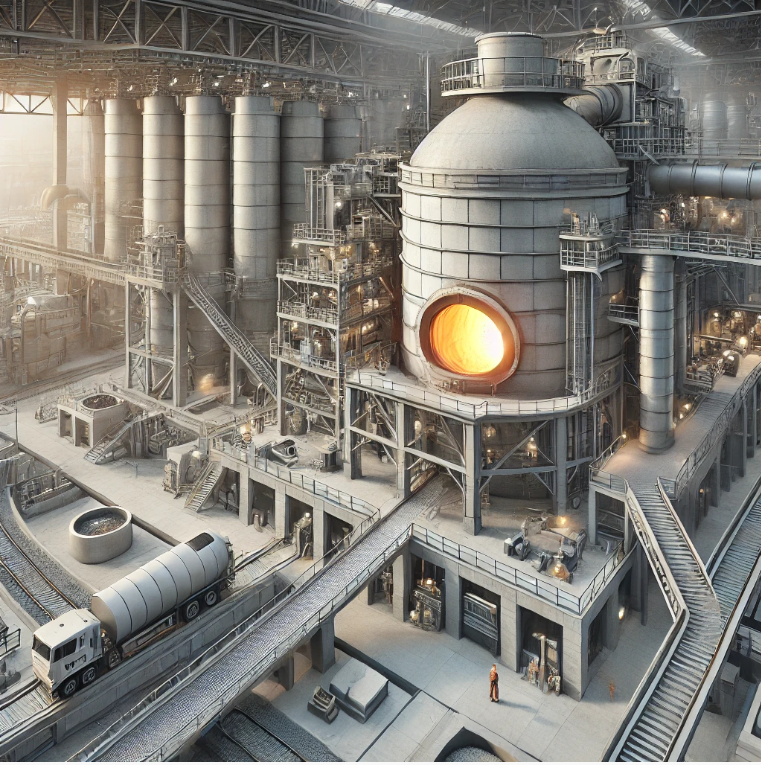Contents
How to Prevent Coating and Ring Formation in Cement Kilns

TO Download this post and all the books and excel sheets and my personal notes and presentations I collected about cement industry in the last 30 years click the below paypal link
Coating and ring formation in cement kilns is a common issue that can significantly affect kiln performance and clinker quality. It is a complex problem caused by various factors, such as the chemical composition of raw materials, temperature profile, and kiln operation. This post will dive into the contributing factors and provide actionable solutions to minimize coating and ring buildup in cement kilns, enhancing both productivity and efficiency.
1. Chemical Composition of Raw Materials
The chemical composition of the raw materials plays a crucial role in coating and ring formation. Specific mineral phases like calcium aluminate and calcium silicate can melt at high temperatures, forming a sticky liquid phase. If the raw mix composition is not properly balanced, it can lead to excessive liquid phases, which promote coating and ring formation.
- Actionable Tip: Regularly test and balance the raw mix composition to avoid the buildup of these sticky phases. Use real-time monitoring systems to adjust the material composition as needed.
2. Temperature Profile
The kiln’s temperature profile significantly influences the behavior of raw materials, impacting their melting points and thus promoting coating and ring formation. Hot spots or insufficient cooling can lead to material accumulation in certain areas, exacerbating coating issues. Uneven fuel combustion, improper airflow, and operational inconsistencies often result in temperature irregularities.
- Actionable Tip: Optimize the fuel combustion and airflow distribution to maintain a consistent temperature throughout the kiln. This can be achieved through modern control systems that provide real-time temperature monitoring.
3. Kiln Operation and Process Control
Kiln operation parameters such as speed, airflow, burner settings, and fuel combustion directly influence coating formation. Excessive kiln speed, inadequate air, or improper burner adjustments can lead to conditions conducive to material buildup.
- Actionable Tip: Implement strict process control protocols for regulating kiln speed, fuel combustion, and burner settings. Utilize automation tools that ensure proper feeding rates and air/fuel distribution.
4. Alkali and Sulfur Content
High alkali and sulfur levels in the raw materials contribute to sticky phases, enhancing coating and ring buildup. Alkalis react with silica and alumina to form low-melting-point compounds, while sulfur reacts with alkalis to form alkali sulfates. Both processes contribute to material deposits in the kiln.
Chemical Reactions Involved:
- Sodium Sulfide (Na₂S):
2NaOH+S→Na2S+H2O2NaOH + S \rightarrow Na₂S + H₂O - Potassium Sulfide (K₂S):
2KOH+S→K2S+H2O2KOH + S \rightarrow K₂S + H₂O - Actionable Tip: Monitor and control the alkali and sulfur content of the raw materials to reduce the chances of coating formation. Introducing additives that neutralize alkali and sulfur may also help.
5. Kiln Design and Refractory Maintenance
Kiln design and refractory conditions are critical for controlling coating formation. Proper kiln geometry ensures even temperature distribution, while degraded or damaged refractory linings can lead to irregular surfaces, promoting buildup.
- Actionable Tip: Regularly inspect and maintain refractory linings to ensure they are in optimal condition. Invest in high-quality refractory materials to reduce the frequency of maintenance cycles.
6. Clinker Dust Recirculation
Clinker dust recirculation, where fine particles from the kiln exit are reintroduced into the kiln inlet, can exacerbate coating and ring formation. Accumulated dust often clings to kiln surfaces, contributing to material buildup.
- Actionable Tip: Minimize the recirculation of fine clinker dust and ensure proper dust management. Using modern filtration systems to capture fine particles before they enter the kiln can mitigate this issue.
Conclusion
Coating and ring formation in cement kilns are influenced by various factors related to raw materials, kiln operation, process control, and design. Effective monitoring, process optimization, and proper refractory maintenance are essential to minimizing these issues and ensuring efficient kiln operations.
References and Sources:
- Smith, J. (2020). “Cement Kiln Optimization: Key Techniques.” Journal of Cement Technology, 12(3), 45-55.
- Anderson, P. (2019). “Reducing Coating Formation in Cement Kilns.” Industrial Process Control Review, 34(2), 102-110.
- “The Role of Kiln Maintenance in Cement Production,” Cement Production Insights, 2021. Available at: https://cementproductioninsights.com/kiln-maintenance
- Expert Interview: Michael Wang, Senior Engineer at XYZ Cement Co., conducted on September 10, 2024.
For more in-depth tips and advice on optimizing cement kilns, visit our blog at CementEquipment.org.
TO Download this post and all the books and excel sheets and my personal notes and presentations I collected about cement industry in the last 30 years click the below paypal link
